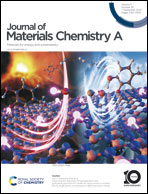Boosted charge transport through Au-modified NiFe layered double hydroxide on silicon for efficient photoelectrochemical water oxidation†
Abstract
Designing an appropriate oxygen evolution reaction (OER) catalyst for photoelectrochemical (PEC) water splitting is an urgent issue for providing high-efficiency solar to hydrogen energy production. Transition metals have been central to OER catalyst research due to their plentifulness and specific electronic structure, but overcoming their water oxidation limits, including high overpotential and sluggish kinetics, remains challenging. The effective usage of noble metals for the OER, such as an intentional introduction of low-concentration noble metals into earth-abundant materials, can complement the limited reserve of noble metals and largely enhance the entire efficiency of solar water oxidation. Herein, we developed an OER photoelectrode of Au-incorporated NiFe layered double hydroxide (LDH) placed on a strong light absorber n-type silicon (Au-NiFe LDH/n-Si). With a minimal Au content of 2.7% in the catalyst structure, synergistic effects between noble metal Au and transition metal-based NiFe LDH notably accelerated the OER kinetics while stabilizing the Si-based photoanode structure in corrosive alkaline electrolyte. Optimally fabricated Au-NiFe LDH through a facile two-step electrodeposition process on n-Si exhibited a high saturated photocurrent density of ∼37 mA cm−2, and the saturated photocurrent density could be reached at an early underpotential point of 1.2 V vs. RHE. Moreover, it operated for ∼50 hours in pH 11.5 electrolyte, showing 5 times higher stability than NiFe LDH/n-Si under the same alkaline conditions. One step further, a 1/48 decrease in recombination kinetics could be achieved through doping Au atoms into NiFe LDH, revealing the efficacious defect site passivation effect with the minimum amount of noble metal usage.

- This article is part of the themed collections: 2023 Journal of Materials Chemistry A HOT Papers and 2024 Journal of Materials Chemistry A Lunar New Year collection


 Please wait while we load your content...
Please wait while we load your content...